Directly under the Arctic Circle! Marianne's Arctic Xpress in Tromsø offers fjord, whale and wildlife tours by day, aurora tours by night. Book Now and get a 10% discount on combo day and night adventures. | | |
CHANCE OF STORMS: NOAA forecasters say there is a 40% chance of minor geomagnetic storms on Aug. 16-17 when a high-speed (700 km/s) solar wind stream brushes against Earth's magnetic field. Glare from the nearly full Moon will, unfortunately, mitigate the visibility of auroras. Aurora alerts: text or voice
SPACE LIGHTNING OVER CHINA: On Aug. 13th in China, photographer Phebe Pan was photographing the night sky, hoping to catch a Perseid meteor. Instead, he witnessed a spectacular bolt of "space lightning." Working atop Shi Keng Kong, the highest mountain peak in the Guangdong province, "I was using a fisheye lens to capture as much of the sky as possible," says Pan. "Suddenly we saw a flash of blue and purple ejected from the top of a nearby thundercloud. It just looked like a tree with branches, and grew up very fast. So awesome!"
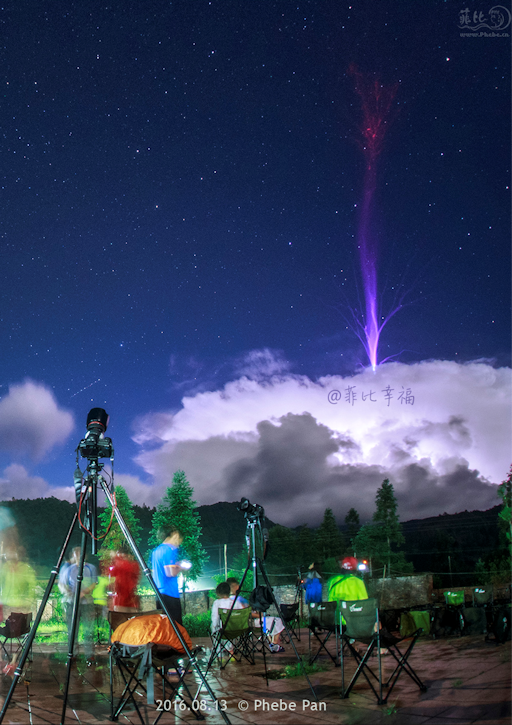
"It just looked like a tree with branches, and grew up very fast," says Pan. "It lasted just less than one second. So awesome!"
Oscar van der Velde, a member of the Lightning Research Group at the Universitat Politècnica de Catalunya, explains what Pan saw: "This is a very lucky capture of a gigantic jet. It's the first time I've seen one captured using a fisheye lens!"
Think of them as
sprites on steroids: Gigantic jets are lightning-like discharges that spring from the tops of thunderstorms, reaching all the way to the
ionosphere more than 50 miles overhead. They're enormous and powerful.
"Gigantic jets are much more rare than sprites," says van der Velde. "While sprites were discovered in 1989 and have since been photographed by the thousands, it was not until 2001-2002 that gigantic jets were first recorded from Puerto Rico and Taiwan." Only a few dozen gigantic jets have ever been seen.
Like their cousins the sprites, gigantic jets reach all the way up to the edge of space alongside meteors, noctilucent clouds, and some auroras. This means they are a true space weather phenomenon. Indeed, some researchers believe cosmic rays help trigger these exotic forms of lightning, but the link is controversial.
Realtime Sprite Photo Gallery
INTERCONTINENTAL BALLOON NETWORK: Aug 21, 2016, is an important date. It's the one year pre-anniversary of the Great American Solar Eclipse. On Aug. 21, 2017, the Moon will pass in front of the sun, producing a total eclipse visible from coast to coast in the USA. To record the eclipse as never before, Spaceweather.com and the students of Earth to Sky Calculus will lead more than a dozen teams of citizen scientists in launching balloons through the path of totality. Our goal: to photograph the eclipse from the stratosphere and create a unique movie of the Moon's shadow sweeping across the continent. Such an ambitious project requires practice, and we're starting now:
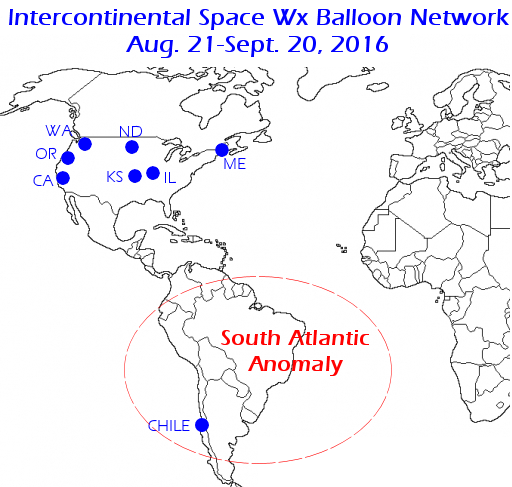
For the next month, we'll be launching groups of balloons from multiple sites around North and South America. Each site (including the one in Chile) will be crewed by students and teachers involved in the Solar Eclipse Balloon Network. Launching large numbers of balloons simultaneously is a key logistical challenge for the 2017 eclipse, and this will be good practice indeed. The first launch on Aug. 21st will involve as many as four balloons lifting off from Chile, California, Oregon and Illinois.
Because our standard eclipse payload includes radiation sensors, we will be learning a great deal about the geographical distribution of cosmic rays in Earth's atmosphere. The Chilean launch, in particular, promises interesting results as it occurs directly beneath the South Atlantic Anomaly. Stay tuned!
Realtime Space Weather Photo Gallery
NOCTILUCENT CLOUDS: NASA's AIM spacecraft, which monitors noctilucent clouds (NLCS) from space, is offline for the next few months while engineers upload a software patch. Meanwhile,observers on the ground are still seeing the electric-blue ripples. Satu Juvonen sends this picture from Raakkyla, Finland:
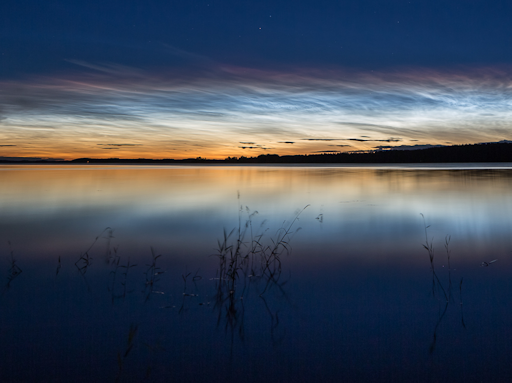
"The noctilucent clouds were incredibly bright on Aug. 13th," says Juvonen. "The display was also special because it had a red fringe on top."
Indeed, that is odd. Noctilucent clouds are best known for their azure hue. Why? The clouds are made of microscopic ice crystals, which form when summertime wisps of water vapor rise to the top of Earth's stratosphere and freeze around microscopic specks of meteor smoke. Very tiny crystals, such as the ones found in NLCs, scatter blue light.
So where did the red fringe come from? Members of the AIM science team asked to explain it weren't sure. One of them, Cora Randall from the University of Colorado, speculated that "light being scattered by the NLCs in this band might be encountering some sort of fine dust layer in the troposphere, which preferentially scatters blue light out of the line of sight, resulting in a reddish tint to the NLCs."
Realtime Noctilucent Cloud Photo Gallery
Realtime Perseid Photo Gallery
Realtime Aurora Photo Gallery
Every night, a network of
NASA all-sky cameras scans the skies above the United States for meteoritic fireballs. Automated software maintained by NASA's Meteoroid Environment Office calculates their orbits, velocity, penetration depth in Earth's atmosphere and many other characteristics. Daily results are presented here on Spaceweather.com.
On Aug. 16, 2016, the network reported 37 fireballs.
(25 sporadics, 11 Perseids, 1 Northern delta Aquariid)
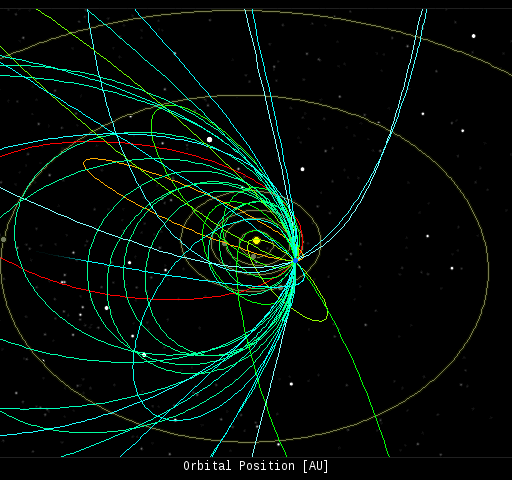
In this diagram of the inner solar system, all of the fireball orbits intersect at a single point--Earth. The orbits are color-coded by velocity, from slow (red) to fast (blue). [Larger image] [movies]
Potentially Hazardous Asteroids (
PHAs) are space rocks larger than approximately 100m that can come closer to Earth than 0.05 AU. None of the known PHAs is on a collision course with our planet, although astronomers are finding
new ones all the time.
On August 16, 2016 there were potentially hazardous asteroids.
Notes: LD means "Lunar Distance." 1 LD = 384,401 km, the distance between Earth and the Moon. 1 LD also equals 0.00256 AU. MAG is the visual magnitude of the asteroid on the date of closest approach. | | Cosmic Rays in the Atmosphere |
| Situation Report -- Oct. 30, 2015 | Stratospheric Radiation (+37o N) |
| Cosmic ray levels are elevated (+6.1% above the Space Age median). The trend is flat. Cosmic ray levels have increased +0% in the past month. |
| Sept. 06: 4.14 uSv/hr (414 uRad/hr) |
| Sept. 12: 4.09 uSv/hr (409 uRad/hr) |
| Sept. 23: 4.12 uSv/hr (412 uRad/hr) |
| Sept. 25: 4.16 uSv/hr (416 uRad/hr) |
| Sept. 27: 4.13 uSv/hr (413 uRad/hr) |
| Oct. 11: 4.02 uSv/hr (402 uRad/hr) |
| Oct. 22: 4.11 uSv/hr (411 uRad/hr) |
These measurements are based on regular space weather balloon flights: learn more. Approximately once a week, Spaceweather.com and the students of Earth to Sky Calculus fly "space weather balloons" to the stratosphere over California. These balloons are equipped with radiation sensors that detect cosmic rays, a surprisingly "down to Earth" form of space weather. Cosmic rays can seed clouds, trigger lightning, and penetrate commercial airplanes. Our measurements show that someone flying back and forth across the continental USA, just once, can absorb as much ionizing radiation as 2 to 5 dental X-rays. For example, here is the data from a flight on Oct. 22, 2015:
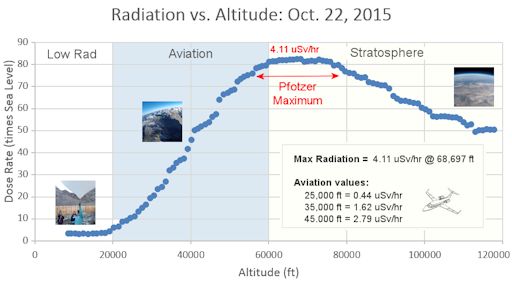
Radiation levels peak at the entrance to the stratosphere in a broad region called the "Pfotzer Maximum." This peak is named after physicist George Pfotzer who discovered it using balloons and Geiger tubes in the 1930s. Radiation levels there are more than 80x sea level.
Note that the bottom of the Pfotzer Maximim is near 55,000 ft. This means that some high-flying aircraft are not far from the zone of maximum radiation. Indeed, according to the Oct 22th measurements, a plane flying at 45,000 feet is exposed to 2.79 uSv/hr. At that rate, a passenger would absorb about one dental X-ray's worth of radiation in about 5 hours.
The radiation sensors onboard our helium balloons detect X-rays and gamma-rays in the energy range 10 keV to 20 MeV. These energies span the range of medical X-ray machines and airport security scanners.
| | The official U.S. government space weather bureau |
| | The first place to look for information about sundogs, pillars, rainbows and related phenomena. |
| | Researchers call it a "Hubble for the sun." SDO is the most advanced solar observatory ever. |
| | 3D views of the sun from NASA's Solar and Terrestrial Relations Observatory |
| | Realtime and archival images of the Sun from SOHO. |
| | from the NOAA Space Environment Center |
| | a proud supporter of science education and Spaceweather.com |
| | the underlying science of space weather |
 | Tobi -- Proud Supporter of Space Education! |
 | Claim your tax refund with this UK tax rebate company and get back your overpaid tax. |
 | Enjoy this fabulous range of leather sofas from a leader in the UK sofa manufacturer industry.. |

